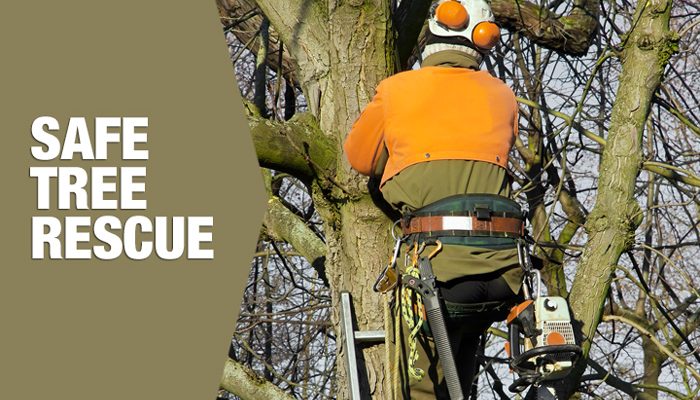
Safe rescue for Arborists
Aerial Rescue from Powered Access Platforms
Even with the right equipment tree cutting at height demands safe working practices. Good climbing techniques should include the regular practice of rescue for operatives who get into difficulty. A minimum of two people must be present during tree climbing and working at height operations. At least one ground member must be competent and trained to perform a rescue from a raised platform.
Good planning is essential:
• A daily programme for the tree work should be established.
• A contact procedure established with a designated person
• Two-way radio / mobile phone communication between ground and raised platform
The Risk Assessment
As part of the pre-work risk assessment, emergency procedures for the recovery and evacuation of casualties needs to be established. All operatives and ground workers need to be trained in these procedures. When a rescue is needed, all precautions must be taken to safeguard other team members. Restrict access to trained rescue personnel only.
Before the Rescue
If overhead power cables are involved, stop work and call the relevant electricity authority.
Try and assess the condition of the casualty. If necessary call the emergency services before attempting the rescue. Help them by giving the exact location and any site access problems they may encounter. Pass on the casualty’s personal details, time of the incident and any treatment given. Notify if any chemicals have been involved.
Worksite Rescue Equipment
The minimum rescue kit that always needs to be available includes:
• First Aid kit
• Climber’s harness and associated ropes, karabiners and associated equipment
• Other climbing equipment including ladders, ropes and climbing irons
• Sharp knife with retractable blade suitable for cutting ropes. Care must be taken when cutting tensioned ropes.
During the course of the rescue assess the situation and send for more equipment as necessary.
The Casualty
• Where possible give reassurances, minimise panic but also encourage self-help
• The rescue method chosen should minimise risk to the rescuer and prevent further injury to the casualty
• If MEWPs or cranes are required for the rescue, ensure the equipment is used by trained operators only
Climbing to the Casualty
• Select a climbing method and get to the casualty as quickly and safely as possible
• If climbing equipment and trained personnel are available, use them to quickly reach the casualty
• Assess the hazards and choose appropriate tree cutting equipment to remove branches that may impede the rescue
• Make the surrounding area safe from hazards
• Assess the casualty’s condition and apply first-aid as necessary
• Take care with serious injuries such as fractures, crush or spinal injuries and only move under trained medical supervision (e.g. paramedics).
Descending with the Casualty
• The rescuer should monitor changes in the casualty’s condition and keep them calm
• The rescuer must ensure their own safety and be securely anchored at all times to enable a safe descent
• Rescuer and casualty should descend together easing movement through branches
• Densely packed branches may require an alternative rescue method
Completing the Rescue
After helping the paramedics and escorting safely from site…
• Ensure site is safe and secure
• Take names and contact details of any witnesses
• Take photos of the site
• Any equipment that is in the incident must not put back into use until it has a thorough examination by a qualified person
• Record in Accident Book and notify management
• Ensure compliance with RIDDOR requirements (Reporting of Injuries, Diseases and Dangerous Occurrences Regulations 1995)
Summary
Good planning as well as regular practice are key to safe rescue operations. An incident may not occur for years, or it could happen tomorrow. All those using powered access platforms are responsible for the safe rescue of operators and staff whenever it is required.